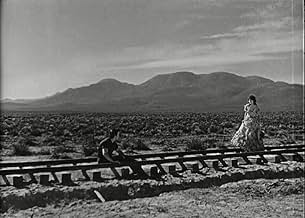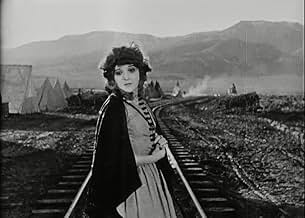Après avoir assisté, enfant, au meurtre de son père par un renégat, Brandon, devenu adulte, aide à réaliser le rêve de son père, à savoir la construction d'un chemin de fer transcontinental.Après avoir assisté, enfant, au meurtre de son père par un renégat, Brandon, devenu adulte, aide à réaliser le rêve de son père, à savoir la construction d'un chemin de fer transcontinental.Après avoir assisté, enfant, au meurtre de son père par un renégat, Brandon, devenu adulte, aide à réaliser le rêve de son père, à savoir la construction d'un chemin de fer transcontinental.
- Réalisation
- Scénario
- Casting principal
- Récompenses
- 2 victoires au total
- Cpl. Casey
- (as J. Farrell Macdonald)
- Pvt. Schultz
- (as James Welch)
- …
- Buffalo Bill Cody
- (as George Wagner)
- Judge Haller
- (as James Marcus)
- Cheyenne Chief
- (non crédité)
- Indian
- (non crédité)
- Worker
- (non crédité)
- Worker
- (non crédité)
- Minor Role
- (non crédité)
- Rail Worker
- (non crédité)
Avis à la une
The story opens with a prologue set in Springfield, Ill., 1853, revolving around Davy Brandon, first as a youngster (Winston Miller) with deep affection towards Miriam Marsh (Peggy Cartwright), his childhood sweetheart. Davy's father (James Gordon) is a surveyor who dreams about the crossing of the western wilderness, while Miriam's father, Thomas Marsh (William Walling), is a skeptic. However, one of the citizens, Abraham Lincoln (Charles Edward Bull), believes in this man's theory and knows he'll accomplish his means. Setting out to accompany his father on a mission to survey an appropriate route through the mountains for the coming railroad, Davy bids a tearful farewell to Miriam. During their westward journey, Davy, who is hidden away because of foreseen danger, witnesses the brutal killing of his father by a white man dressed up as an Indian whose only identification if the loss of a thumb and two fingers on his right hand. After burying his father, Davy is taken in by a passing scouting party. A decade later, 1862, Abraham Lincoln is president of the United States; Davy (George O'Brien) is a Pony Express rider out to fulfill his father's dream leading into the building of the Transcontinental Railroad; and Miriam (Madge Bellamy), now engaged to Peter Jesson (Cyril Chadwick), an Eastern surveyor working for her father actually working for Deroux (Fred Kohler), the richest landowner, who stands to profit if the railroad goes through instead of through the pass. After being reunited with Miriam, Jesson finds himself in stiff competition. The two men become bitter enemies, especially after Jesson's attempts in doing away with him. Matters become complex until the golden spike gets hammered into the rail on that historic day of 1869 as east meets west through the continental railroad.
In the supporting cast are Gladys Hulett (Ruby); Jack O'Brien (Dinny); three musketeer pals of J. Farrell MacDonald (Corporal Casey); Francis Powers (Sergeant Slattery); and James Welch (Private Schultz), as well as historical figures of Buffalo Bill Cody, Wild Bill Hickock and John Hay enacted by George Wagner, John Padjan and Stanhope Wheatcroft.
THE IRON HORSE (title indicating the locomotive train) plays like a D.W. Griffith production with prologue, historical figures, flashbacks and epilogue, and like a screen adaptation to an Edna Ferber novel telling its story through the passage of time, along with soap-opera ingredients (complicated love triangle), but no usual conclusions of central characters going through the white hair and wrinkles aging process. Overall, this is John Ford's storytelling, cliché as it may be, placing fictional characters against historic setting, along with the oft-told murder-mystery subplot of a son out to avenge his father's killer, a historical movie that's become an important part of cinema history. Ford, the future four time Academy Award winning director, with a handful of motion pictures to his credit, best known for westerns, would provide similar themes in his future film-making. As popular as THE IRON HORSE was back in 1924, it's amazing that Ford didn't attempt doing a remake, especially in 1939 when westerns reached it peak of popularity. It took Cecil B. DeMille to attempt a similar story with UNION PACIFIC (Paramount, 1939) starring Barbara Stanwyck and Joel McCrea. Like THE IRON HORSE, UNION PACIFIC, which tells its story in over two hours, features villains, Indian massacres and thousands of extras.
George O'Brien, a rugged actor, was an ideal choice for the role of Davy Brandon. Although he worked under Ford's direction numerous times in latter years, and showed his capability as a dramatic actor in F.W. Murnau's SUNRISE (1927), he never achieved major stardom. He did work steadily mostly in "B" westerns through the early 1950s. Co-star Madge Bellamy offers her typical heroine performance, caught between two men who vie for her affection, but is far from being a strong character. While the acting overall is satisfactory, from today's viewpoint, some heavy melodramatics as the method of fainting by youngster Davy after witnessing his father's massacre, or Bellamy's performance in general, might provoke some laughter. Scenes such as these can be overlooked by great location scenery as Monument Valley, a race against time and action scenes typically found in Ford westerns.
Television history to THE IRON HORSE began when it became one of the movies from the Paul Killiam collection to air on public television's 13-week series of "The Silent Years" (June-September 1975), hosted by Lillian Gish. In her profile about THE IRON HORSE (accompanied by an excellent piano score by William Perry), Gish talks about its location shooting in the Nevada desert, the use of 100 cooks to feed the huge cast, and 5,000 extras consisting of 3,000 railway workers, 1,000 Chinese laborers, many horses and steers. Decades later, THE IRON HORSE made it to the American Movie Classics (1997-1999) and Turner Classic Movies (TCM premiere December 9, 2007 ) accompanied by orchestral score with 15 minutes of additional footage as opposed to the 119 minutes presented on both "The Silent Years," and the Western Channel in 2001. Distributed to home video Critic's Choice in 1997, availability on DVD came a decade later.
THE IRON HORSE may not be historically accurate as promised through its opening inter-titles, but it's sure an ambitious John Ford production to still be entertaining today. (****)
I had seen this movie several years ago and was delighted to see it being broadcast on the Turner Classic Movies channel. Perhaps they will re-broadcast it again in the future.
This movie, while not completely accurate historically, certainly gives an idea of the magnitude of the endeavor being undertaken. And it does feature a real locomotive which operated on the railroad during the period portrayed. Historical buffs definitely should not be swayed from enjoying this title simply because it may not strictly conform to history.
I won't go into the story except to say that the various sub-plots keep the viewer very entertained. This was a very well-done movie in my opinion. Acting was very good. And the cinematography was very impressive.
Fans of either westerns or silent-era films certainly should not miss this one.
Bursting with excitement & patriotic fervor, THE IRON HORSE is the film which put young director John Ford on the cinematic map. He brought together all he had learned from years of making shorter, smaller films and he produced a product which heralded his enormous contributions to sound films in the years to come. This is a `director's picture' in that the stars, as good as they are, are almost negligible; what was important here was Ford's vision & his ability to place it before the audience. Indeed, he does not even bring his leading man (George O'Brien) on screen until 45 minutes into the story - a shortcut to disaster almost anywhere else.
(In all fairness it should be noted that O'Brien, handsome & strong-limbed, does very well as the gentle hero. He would find similar roles in other epic films of the decade. J. Farrell MacDonald, as Irish Corporal Casey, is the prototype for many comically eccentric fellows who would appear in other Ford westerns.)
The film often takes on the aspects of an ancient newsreel. Cattle drives, Indian attacks & endless track laying all look utterly real. Particularly fascinating is the depiction of the dismantlement of the end-of-the-track town, so that not even a dog is left, as it is moved many miles further on to the west. This type of arcane information is what makes watching very old films so enjoyable.
THE IRON HORSE represented the largest migration out of Hollywood for location shooting up to that time. Nothing like this had been attempted before, so Ford & his lieutenants were forced to make up the rules as they went along.
Hiring a circus train, the small army of extras arrived at the subzero Nevada location in January of 1924. The conditions which greeted them were authentically primitive. It was so cold, the extras quickly began sleeping in their costumes. Finding the train to be flea ridden, they moved into the sets and began living exactly as the characters they were portraying. The female extras especially suffered from the rugged conditions. A frontier mindset seemed to take over many of the cast & crew; the circus tent, which doubled as both the movie saloon and the crew's commissary, eventually had to have the catsup bottles removed from the tables to discourage the many fights which kept breaking out.
Authenticity found its way into the movie in other, more positive, ways. Several of the elderly Chinese extras, representing laborers on the Central Pacific, had actually worked on the real McCoy sixty years previous. They came out of retirement to appear in the film & enjoyed themselves immensely. Ford also managed to locate the two original locomotives which met at Promontory Point, Utah, in 1869 and reunited them for the film's climax.
Composer John Lanchbery has contributed a splendid soundtrack to the restored video version, incorporating several contemporaneous tunes of the period. It would be intriguing to double bill THE IRON HORSE with Cecil B. DeMille's UNION PACIFIC (1939), which tells the same historical story, but with a completely different tack & set of fictional characters.
Le saviez-vous
- AnecdotesThe kitchen staff for the film was made up largely of Chinese cooks. Some of them had been workers on the transcontinental railroad in 1869, the same construction project that forms the basis of this film.
- GaffesPony Express riders are shown under attack from Indians in 1867. The Pony Express was in operation from 1860 to 1861 when it was rendered obsolete by the telegraph.
- Citations
Thomas Marsh: [after Brandon, Sr. leaves to go west to pursue building a transcontinental railroad] Poor dreamer - he's chasing a rainbow!
Lincoln: Yes, Tom - and some day men like you will be laying rails along that rainbow.
- Versions alternativesThe DVD release of this film contains two different edits, one for the American market and one for Europe. The American release is 16 minutes longer than the European cut. The American cut is dedicated to the memory of Abraham Lincoln while the European release is dedicated to the memory of George Stephenson. In the American release Fred Kohler's character is named Deroux while in the European cut his character is named Bauman.
- ConnexionsEdited into The Story of Our Flag (1939)
- Bandes originalesBlow the Man Down
(uncredited)
Traditional 19th Century Sea Chanty (1860s)
[Integrated into restoration score into divorce and going back to work scenes]
Meilleurs choix
- How long is The Iron Horse?Alimenté par Alexa
Détails
Box-office
- Budget
- 450 000 $US (estimé)
- Durée2 heures 30 minutes
- Mixage
- Rapport de forme
- 1.33 : 1
Contribuer à cette page



































